 |
|
|
Popular topics on this page:  A stapler and the art of diagnosis
A stapler and the art of diagnosis
Transfer an Adobe license
Stable sorting in a DataGridView
Virtual PC and OS/2 More OS/2
How to Photoshop an aerial photograph
Astrophotos: Jupiter's 2 red spots
Jupiter in 3-D
Space Shuttle and ISS
 For more topics, scroll down, press Ctrl-F to search the page, or check
previous months.
For more topics, scroll down, press Ctrl-F to search the page, or check
previous months.
BOOK SALE - I'm selling off some scholarly books via Amazon
Marketplace. Have a look!

|
2006
July
29-31
|
End-of-month oddities
I'll close out the month with a selection of odd links that have come my way lately.
Odd regulations: Look at the rules governing
what can be mailed from the U.S. to Italy.
You can't send plastic toys, or typewriter ribbons,
or shoes.
All I can guess is that Italy has a truly weird tax system,
combined with a notoriously unreliable post office.
I just sold a secondhand book to an Italian; I hope he gets it!
Here
is a good think piece on mail-order degrees.
I would like to see the Federal Trade Commission and other authorities take a much
stronger role in combatting educational fraud.
If they can restrict the use of the word "cheese," why not "Ph.D."?
One of the saddest aspects of the problem is that
real universities suffer when someone sets up a diploma mill with the same name.
La Salle University in Philadephia is highly respected, or deserves to be;
La Salle University of Louisiana (and wherever else it moves to) isn't.
Shouldn't trademark laws take care of this?
Sysinternals
has been bought out by Microsoft.
Download their free Process Explorer utility if you haven't already done so; it's useful!
The British Army has concluded that
bagpipes are hazardous
to the ears. All England chuckles and all Scotland winces at the news...
That's all for July. I'll see you in August.
Permanent link to this entry


|

|
2006
July
27-28
|
The clever pinout of the new PIC microcontrollers
 While I wasn't looking,
Microchip, Inc.,
changed the pinout of its popular
PIC microcontrollers
in a clever way.
While I wasn't looking,
Microchip, Inc.,
changed the pinout of its popular
PIC microcontrollers
in a clever way.
My old favorite, the PIC16F84A, with 18 pins, has faded into the background.
The new chips have 8, 14, or 20 pins.
What's more, they're very cheap (40 cents for a bottom-of-the-line 8-pin device)
and require no external components except a power supply
(although you can still use crystal or RC oscillators if you want to).
A development system with a good, short textbook,
the PICkit 2,
is offered for $50, and there's a
free C compiler
although it doesn't support all the same chips (if you want to use it, the PIC12F629 and PIC16F690 are good choices).
What's clever is the pinouts. As you see in the diagram, the leftmost 8 pins are the same on all these chips.
The 14-pin chips all add six more, and the 20-pin chips add another six.
This means you can build programmers and development tools that have a single socket into which
you can plug any of the 8-, 14-, or 10-pin PIC microprocessors.
What's more, the V+ and V- pins are no longer in the middle of the package — which means that if you
turn the chip backward in its socket, you're not applying power backward.
Instead, V+ and V- will be connected to digital inputs, current will only flow through input-protection diodes,
and the chip has a chance of surviving the
accident (I haven't tried it!). Our favorite method of accidentally destroying PIC microcontrollers is a thing of the past.
For the uninitiated, I should add that each of these chips is a complete computer,
with CPU, ROM, RAM, and I/O ports. Some of them have serial ports, analog-to-digital converters,
and other gadgetry. They're for controlling machinery, such as thermostats, coffee makers,
wristwatches, and what not.
We are now living in an era where a computer costs less than a capacitor.
I may actually use a PIC instead of a 555 timer when I rebuild the dew-heater
controller for my telescope. It's less expensive.
What we lose, of course, with a programmed microcontroller in every gadget,
is repairability.
If a PIC microcontroller, programmed by someone else, fails in use,
I can't replace it; I don't have the program.
Permanent link to this entry


|

|
2006
July
25-26
|
No, they don't baptize cars...
Oddest news story of the week:
This one made News of the Weird
in what I thought was distorted form, but no, it's really that strange.
The
Levenshulme Baptist Church
(Manchester, England)
advertised a car wash using "holy water," by which they meant water from draining their baptistry
(their tank for baptizing adults by immersion, a structure rather like a hot tub).
The trouble is, Baptists don't normally use the term holy water and certainly have nothing
like the holy (blessed) water that Catholics use in some blessing ceremonies (not baptism).
So numerous Baptists,
including me, wrote to News of the Weird to point out that the terminology was wrong.
But in fact the terminology was just what the Levenshulme people were using.
And note the Roman collar on their minister in the photograph. Must be very high-church Baptists.
Permanent link to this entry
24 years...
Yesterday Melody and I celebrated our 24th anniversary.
As we start our 25th year of marriage, all I can say is that 25 centuries
would not be enough. We're permanent.
Permanent link to this entry


|

|
2006
July
24
|
More OS/2
(I thank Madcrow Maxwell for helpful tips.)
 I've been tinkering with OS/2 under Virtual PC again.
Today I added FixPack 42 and Virtual Machine Additions.
The latter give better interoperability with the Windows host — most
noticeably, Virtual PC no longer hogs the CPU, and the mouse can be moved in
and out of the OS/2 window without explicitly pressing right-Alt to change modes.
I've been tinkering with OS/2 under Virtual PC again.
Today I added FixPack 42 and Virtual Machine Additions.
The latter give better interoperability with the Windows host — most
noticeably, Virtual PC no longer hogs the CPU, and the mouse can be moved in
and out of the OS/2 window without explicitly pressing right-Alt to change modes.
The procedure wasn't simple. Here's what to do (starting with OS/2 Warp 3):
(1) Make a backup copy of your OS/2 virtual machine (in My Documents\My Virtual Machines), just in case.
(2) Go to Hobbes and download
FixPack 42 for Warp 3, b120.zip (which allows high-numbered fixpacks to install on
non-network versions of Warp 3), and SimpleFix (sfx41.zip), which lets you install
the fixpacks from
downloaded diskette images without having to make diskettes.
(3) Unzip each of these downloads into a separate folder and put them all on a CD-ROM.
(4) Install b120.zip. This is done almost the way the instructions say. Assuming
b.cmd is on d:\b120, what you do is:
— First, e d:\b120\b.cmd and read the comments.
— Then, if not deterred: [C:\] d:\b120\b cool
It's important for C to be the home drive at the time b.cmd executes.
Your internal OS/2 version number has now been hacked. Don't worry...
(5) Install SimpleFix. That is straightforward.
(6) Start SimpleFix and point it to the first of the diskette images of FixPack 42.
(It will find all the rest.)
SimpleFix asks whether to run SYSZMPM.CMD. I checked "yes."
SimpleFix then starts IBM's fixpack installation program, which will
ask you for two archive folders. I typed in c:\archive1 and c:\archive2,
perhaps not the best-thought-out names, but they worked.
(7) After rebooting, close SimpleFix (which, like a zombie, doesn't close its own window
when it finishes — and this being OS/2, that window is still there after rebooting).
Then choose Action, Install Virtual Machine Additions.
This puts a fake CD-ROM in the virtual CD drive.
Navigate to the OS/2 installation program on it and run it.
Since Virtual Machine Additions are for Warp 4, you'll see lots of error messages,
each with a railroad-like "clang clang" sound.
But the installer isn't doing as badly as it thinks.
One component, VMGRADD, will unpack and install just fine. Let it do so.
(8) Reboot and enjoy OS/2.
There. Now I have a fine OS/2 virtual machine running... and no application software at all!
Am I crazy? Mostly I just wanted to experience the odd OS/2 user interface again, complete with
"clang clang" sound effects. I have a copy of Borland C++ for OS/2 around here somewhere...
By the way, OS/2-philes who read German will enjoy
Robert Fuchs' helpful notes.
Permanent link to this entry


|

|
2006
July
23
|
Up in the air
How to Photoshop an aerial photo


The highlight of yesterday was a visit from my cousin, Tonita Branan, and her husband, Brad Brechtelsbauer, whom I hadn't
seen in years. Brad is a physician and Tonita is a faculty member in English Literature at
Eastern Carolina University. We're the erudite branch of our very diverse extended family :)
They came in their 6-seat Cessna airplane, and Brad took me up in it, along with my nephew, Aaron Paul.
We flew over Athens and I got a lot of interesting pictures. Later, I worked out a fairly sophisticated Photoshop
procedure for getting the best quality from the digital images.
To see one of the best pictures, along with a disquisition on how I used Photoshop,
click here.
The picture is of the University of Georgia's South Campus, centered on the building in which I work.
Permanent link to this entry


|

|
2006
July
22
|
Does "Hallelujah" mean "Buy Nextel"??!
I've just seen a Nextel television ad that is
either a crass display of cultural illiteracy, or possibly something worse.
It uses snips of Händel's Hallelujah Chorus to herald something about Nextel's rate plan.
Do the makers of the ad think Hallelujah simply means "Hooray"?
It doesn't.
It's Hebrew for "Praise the Lord" and contains part of the Divine Name,
which Jews consider sacrosanct.
And the Hallelujah Chorus is one of the most revered Christian hymns.
It almost sounds as if they are deliberately making fun of both Christianity and Judaism.
I've written to both Nextel and the TV station to register my protest.
Permanent link to this entry


|

|
2006
July
21
|
Miscellany
It's the bank's fault:
I agree wholeheartedly with
this commentary,
which says that identity theft is a problem for banks and the credit industry to solve
and shouldn't be blamed on the victims or even the Internet.
Banks, credit card issuers, merchants, and services such as Paypal and eBay are
just too gullible in accepting online transactions from anybody and everybody
without verification. It's not our job to do security for them.
Metaphors to laugh at:
Check out
these,
on the Car Talk humor pages.
Good cheap pen:
Pilot "Varsity"
disposable fountain pen. My girls gave me one the other day.
I don't approve of
its disposability, of course, but it writes well and contains lots of high-grade black ink.
I'll probably do an illustrated article on how to make it into an italic calligraphy pen. (Clip off the end,
smooth with a whetstone, round the corners very slightly, and do the final smoothing by writing on
#400 and then #1500 sandpaper, varying the pen position constantly as you write.) More on this later.
Want a PCMCIA (PC Card) wireless adapter with external antennas?
Just
dismantle a
Linksys BEFW11S4 router.
Hmmm, I have a battle-weary BEFW11S4 lying around...
Permanent link to this entry


|

|
2006
July
20
|
Off to India
It used to be that "studies abroad" meant a short trip to France or England.
Not any more!
Cathy had a good trip to Ecuador recently, and today
we're packing Sharon off to India with her high school (Athens Academy).
They're helping to rebuild a school that was hit by the tsunami a year and
a half ago.
Permanent link to this entry


|

|
2006
July
19
|
Lithium battery secrets
Both of our DSLRs, my Canon and Cathy's Nikon, use 7.2-volt lithium-ion (Li-Ion) batteries.
One of the Canon batteries started running down prematurely, and I did some investigating.
As you might imagine, the nominal 7.2-volt rating is basically fictitious.
Fully charged, lithium batteries measure more than 4 volts per cell, or 8 volts for the whole battery.
The other thing to know is that charging continues for an hour after the charger indicates
full charge.
Don't yank the battery out prematurely.
The charger monitors the battery voltage and adjusts the charging current accordingly, but the
last hour of trickle-charge, after full voltage has been reached, is crucial if you want maximum capacity.
Our defective Canon battery was only charging up to 7.6 volts or so.
Having nothing to lose, I decided to run it through the charger again, just to see what
would happen.
The charging cycles were very short because the battery would level off at constant
voltage very quickly.
Guess what? On the fourth charging cycle,
the battery came up to 8.2 volts, and since then, it has acted perfectly normal.
More useful information on lithium-ion battery charging is
on
Panasonic's
web site.
Follow the links to the technical notes.
Permanent link to this entry
Miscellany
You'll notice that this page no longer displays Google ads. The ads were supposed to change in accordance with
the subject matter of the page, and for a while they did, but when I mentioned stem cell research,
Google Ads got stuck on the subject of blood banks. Before that, when I mentioned Adobe customer support,
the computer that places the ads became unduly fascinated with customer support services. So I've taken them down
and put up a banner advertising some of my own books.
Here
is a good page on how to repair wall-warts (modular plug-in power supplies).
The trick is getting the plastic case open with a minimum of destruction.
The defect is usually that the cord is broken right where it comes out of the case.
A hot issue in the electronics industry right now is
lead-free solder, required by European safety regulations being phased in now.
We know that the melting point is higher and that the overall performance of the solder is a bit worse
than the tin-lead solders we're used to.
In particular, automated equipment may not get the new-style solder hot enough unless it is
readjusted carefully.
But there's a worse problem: tin whiskers. New-style solder is almost pure tin and has the ability to
recrystallize in a very strange way. Atoms move around and form whiskers that can be long enough to create
short circuits between IC pins. This is a slow process; equipment that works fine for the first couple of years
can fail later. This can even happen inside the sealed packaging of transistors and other components.
More information is
on NASA's tin whisker page. (Your space exploration dollars at work!)
Cynics are saying that the consumer electronics industry wants our telephones,
stereos, etc., to go bad after a few years, so we can get new ones.
Permanent link to this entry


|

|
2006
July
18
|
A better LX200

Yesterday's achievement is that I redesigned the power inlet circuit
of my Meade LX-200 telescope (vintage 2000) to overcome
a couple of quirks.
In the original circuit, the metal frame of the telescope wasn't grounded; now it is, so allowing other grounded
equipment to touch it won't give me any surprises.
Also, the protection against reverse polarity was imperfect.
Click on the diagram above for more about this.
Then I had a good evening of astrophotography under miserably hazy skies.
It's amazing how much more the camera can see than I can.
Permanent link to this entry
Miscellany
If you like old star charts and astronomy pictures,
have a look at
this online
collection at the U.S. Naval Observatory.
Here's a clever idea:
mount lights
on the back of your computer monitor
so that they illuminate the wall without shining on the screen.
Hobbes lives!
The online FTP archive of OS/2 software is still operating.
That's where I got LaTeX for OS/2 about 12 years ago.
Permanent link to this entry


|

|
2006
July
17
|
Christians are not against stem cell research
News stories such as
this
one, distilled down to 5-word sound-bites,
have given some people the impression that Christians are against all human stem-cell research.
And that, in turn, gets spun to make it sound like we're against curing dreaded diseases and
healing spinal-cord injuries.
It led the late
Christopher Reeve,
to voice the ridiculous opinion that religious people shouldn't have a voice in public policy.
Someone had apparently convinced him Christians were against curing his spinal cord injury.
Well... what's going on, then?
What we're against is destroying human embryos to harvest stem cells.
There are plenty of other ways to get stem cells — umbilical cord blood,
placental tissue, adult tissue — and what I hear from my biologist colleagues
is that all of these work better medically
than embryonic stem cells, as far as they can tell.
The practice of breaking up a human embryo in order to get cells to use treating someone else
is an assault on human personhood that ought to stop.
As Dr. Seuss put it, "A person is a person no matter how small."
We do not kill one human being, even an embryo, to cure a disease in another.
And it appears to be a medical dead-end, too.
(See also this.)
Permanent link to this entry
More Virtual PC notes
I've had some adventures setting up several Virtual PCs.
Some notes:
The way I approached Windows 95, since the install CD is not bootable, was to first create a DOS
virtual machine with CD-ROM support. To do that, create a DOS VM and install Virtual Machine Additions,
which I'm about to describe. Then
install Windows 95 from "setup" on the CD.
At one point Windows 95 strangely could not find some files on its CD. Many things
can cause this problem, but in my case, the trouble was that the drive letter for
the CD had changed! Memorandum: Keep the DOS boot disk simple and give
the CD the same letter under DOS that it will have under Windows.
There are Virtual Machine Additions for Windows, OS/2, and DOS. They all do somewhat different
things, but they give your virtual machine better interaction with the real machine on which it runs.
For Windows 95, 98, etc., installing the additions is very easy;
just choose Action, Install Virtual Machine Additions,
while the virtual PC is running.
For DOS it's non-trivial. The instructions given
here
are
maddeningly close to being right.
You drag a .vfd file that comes with Virtual PC onto the floppy disk icon at
the lower left, and that makes it into a virtual Drive A on which you can run scripts.
The trouble is, the script they provide (DOSADD.BAT) only works for DOS 6 or 7.
I had DOS 5.
Fixing the script is simple. Make a copy of DOSADD.BAT in C:\. Edit it to change
all "/y >nul" to blanks and to remove the "choice" command near the beginning.
Then it works; it runs; it gives you better CPU sharing (so the DOS process isn't 100% of your CPU!)
and access to the CD-ROM drive.

Now then. Emboldened by my success with DOS, Windows 3.1, and Windows 95, I dusted off my
copy of OS/2 Warp 3.0 ("Warp" as in Star Trek) and installed that too.
It may be the least useful thing I've done with a computer in a long time, but it was fun.
I followed the detailed instructions given by "Virtual PC Guy" here.
These are vital if you want the CD-ROM to work.
For a brief and shining moment around 1994, OS/2 was the future of PCs.
In the late 1980s, Microsoft and IBM were working on a joint project to replace DOS with
a totally different operating system.
They parted ways around 1990.
The Microsoft project became Windows NT (which we ignored) and then Windows 95.
Ahead of Windows 95, IBM brought a similar product to market.
Melody and I used it to multitask DOS applications and to run a large-memory
version of LaTeX typesetting software.
In the software industry, OS/2 was "a better DOS than DOS" and was popular with
software developers because you could run multiple copies of DOS, each in its own
box, each with separately set parameters.
Internally, OS/2 was very solidly built. Crashes were rare.
OS/2 is still used, to this day, in cash registers and automatic teller machines,
partly because it's reliable and partly because virus authors never got around
to targeting it.
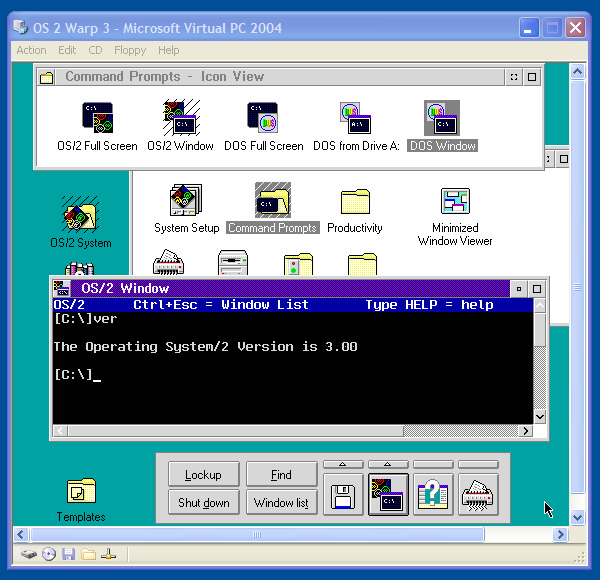
But the user interface looks like — how shall I say this nicely? — a parody of Windows 95.
The OS/2 people were groping for what Windows 95 found.
OS/2's windows minimize into complete invisibility; you have to use the Minimized Window Viewer
to retrieve them. There is no taskbar. It's easy to get lost.
Then there are the sounds.
Most of us, during the heyday of OS/2, were fortunate enough not to have sound cards.
As a result, we never knew that OS/2 sounded like
this starting up and
this shutting down.
Click and listen! Each "plip" is the sound of a window opening or closing.
And today I discovered that when you try to read from A: and there's no diskette in the drive,
you get a clang clang that would delight a model railroader.
Permanent link to this entry
Press OK to cancel, Cancel to continue...
While installing OS/2, I came across this priceless message box...
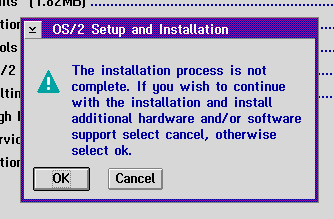
Read it again. It reminds me of Raymond Smullyan's remark,
"I cannot fail to disagree with you less."
Permanent link to this entry


|

|
2006
July
16
|
Miscellany
Uploaded July 15! Read tomorrow's news today!
Fake USB flash drives:
Someone has been caught reselling
1-GB drives labeled as 8 GB. They work, and if you don't check the size carefully, you don't notice
anything is wrong.
Jim Chen has posted
information about the
infrared filters inside digital SLRs, including transmission curves.
As you know, silicon sensors are very sensitive to infrared, which has to be blocked for normal
color photography.
Astronomers have been buying DSLRs modified by
Hutech to
increase their infrared sensitivity.
See also this FAQ about astronomy with the Nikon D50.
What good is a dead cell phone?
We have some old unactivated Cingular TDMA phones, and the other day I charged one up to see if it would work at all.
As everybody knows, an unactivated phone can still call 911 (I didn't actually try that).
To my surprise, it can also call regular numbers, for a price.
Dial a regular number, and it connects to
American
Roaming Network and asks for a credit card number. You can talk for about $2 per minute, which is some of the most
expensive telephony in the world, but could save your life in an emergency.
As a South Georgia native, I regret that I didn't hear about the
WALB tower collapse
more promptly. (Follow the link and watch the video; it's a classic.)
WALB, a.k.a. Channel 10, was one of the two TV stations we got in Moultrie and Valdosta when I was a boy.
Here is some discussion of those
cheap Insignia speakers that I mentioned the other day.
The consensus? Quite good for $50; the gold binding posts alone could cost that much at an audio boutique.
Not great speakers, of course, but good cheap speakers.
Incidentally, my other recent speaker hack has been to replace the tweeters in my
cheap 3-speaker (2.1) Juster set with the Minimus-7's removed from the real stereo.
Much better!
Permanent link to this entry


|

|
2006
July
14-15
|
Virtual PC

Microsoft Virtual PC 2004 is now a
free download.
This is a program that pretends to be a complete PC that can boot almost
any operating system. (There's an ersatz AMI BIOS in it, complete with setup mode.)
Its "hard disk" is a file on your real hard disk, and it normally cannot write on any of
your other files.
Above you see Windows 3.1 running in a Virtual PC box.
I also have a Windows 95 box, and I'm going to set up an OS/2 one.
The Windows 95 one considerably benefited from installing
"Virtual Machine Additions," a set of extensions to Windows 95 that
allow it to communicate with Virtual PC.
That opens up more communication between the virtual machine and the
real one on which it resides.
It also fixed an odd problem with the mouse cursor not being where
Virtual PC thought it was.
The virtual machines contain real Windows 3.1 and 95, installed
from their own disks — not emulation
modes — and Cathy and Sharon are going to use this technology to run
some older games.
Note that Virtual PC does not include the operating systems you're going to run
under it. You have to dig out your old Windows 3.1 disks and install from them.
Each virtual machine actually comes with an unformatted hard disk and wants
to boot from diskette drive A until you set it up to do differently.
Word to the wise: Install CD-ROM support.
Remember that CD-ROM support isn't built into DOS or Windows 3.1.
The difference between Virtual PC and various kinds of multi-boot systems
that in Virtual PC, disks other than the disk space assigned to a virtual machine
are absolutely invisible to it. Thus, malware or malfunctions in a virtual machine
can't trash the rest of your data.
I presume there's a way to share disks between virtual machines and the real one,
but I haven't found it yet.
Virtual PC has a cult-like following, and as you can see, I've almost been drawn in.
The reason Microsoft is giving it away free is apparently that Virtual PC 2004
won't virtualize Windows Vista; there will be a new version for that.
Permanent link to this entry


|

|
2006
July
13
|
How (not) to transfer an Adobe license
Revised July 14.
When you take an Adobe product off your computer and want to sell it to another
person, you should transfer the license so that the new owner can register it
and get customer support.
Adobe even provides a "transfer license" procedure that is basically online
de-activation so you can tell Adobe, through the Internet, that you are
removing the software from your computer. You should definitely do this when
de-installing it.
And then what do you do? Unfortunately, at this point Adobe's elegant system
broke down.
Their e-mail customer support system auto-replied with misinformation.
Specifically, they told me that in order to transfer a license, I should go to
http://www.adobe.com/support/salesdocs/1000554.html, which is, as far
as I can tell, a dead link. And of course if I reported the problem, I got another
misinformed auto-reply.
Fortunately, using Google, I was able to find a cached copy of that web page.
Here are the crucial instructions:
To transfer an Adobe license:
1. Contact Adobe Customer Service by phone to obtain a case number. Failure to
contact Customer Service will result in processing delays.
2. Complete the Transfer of Adobe License form. Provide all information for
both the transferer and the transferee, including your case number.
3. Have both the transferer and the transferee sign the Transfer of Adobe
License form.
4. Return the completed form to Adobe Systems Incorporated at the following
address:
Adobe Systems Incorporated
Transfer of Adobe License
Adobe Customer Service
PO Box 2205
Beaverton OR 97075
Fax: 800-955-1610
Allow three to four weeks for your request to be completed.
|
The transfer of license form is fortunately still on line
here.
Followup: About a day later, I got e-mail from a human being at Adobe.
Apparently they do read their e-mail.
But the bad news is that educational licenses aren't transferable. So I
own 2 copies of Illustrator.
Permanent link to this entry
Stable sorting of a DataGridView
The sorting algorithm used in the .NET 2.0 DataGridView component is not
stable. That is, if you sort column A (by clicking at the top of it) and then
sort column B, items with the same value in column B will not remain
sorted by column A.
This is inconvenient. If, for example, you'd like to sort grades by courses
and, within that, by student name, you can't do it.
The sorting algorithm used is apparently some variety of
Quicksort and .NET Framework does not give you a good way to replace it
with a stable sorting algorithm
What you can do is replace the comparison function that decides whether
elements are in the right order. And that is the key to today's clever
hack:
-
Keep a list, in order, of the columns that have recently been sorted.
-
When two elements come up for comparison and have the same value in the column
on which you're sorting, look at the other recently sorted columns, most
recent first, until you find something different.
The list of recently sorted columns is maintained by handling the Sorted
event, which arises at the completion of each sort. The comparing is done by
the SortCompare event handler. The C# code looks something like this:
ArrayList recentlySortedColumns = new ArrayList(10);
private void dataGridView1_Sorted(object sender, EventArgs e)
{
recentlySortedColumns.Add(dataGridView1.SortedColumn);
}
private void dataGridView1_SortCompare(object sender,
DataGridViewSortCompareEventArgs e)
{
int result = System.String.Compare(e.CellValue1.ToString().Trim(),
e.CellValue2.ToString().Trim());
if (result == 0)
for (int i=recentlySortedColumns.Count-1; (result==0 && i>=0); i--)
{
DataGridViewColumn col =
(DataGridViewColumn)recentlySortedColumns[i];
result = System.String.Compare(
dataGridView1.Rows[e.RowIndex1].Cells[col.Name].Value.ToString(),
dataGridView1.Rows[e.RowIndex2].Cells[col.Name].Value.ToString()
);
}
e.SortResult = result;
e.Handled = true;
}
|
Note that the sorting algorithm, for unknown reasons, compares each row to
itself once. The code, as shown, does a bit of unnecessary work when this
happens; cutting out the unnecessary work is left as an exercise for the
student.
Permanent link to this entry
 
|

|
2006
July
12
|
Another brush with fame
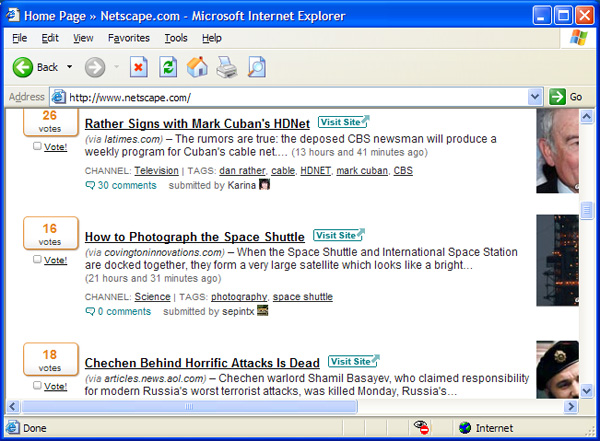
I've been "aggregated" again. My page on
how to photograph the Space Shuttle made it to the front page of
www.netscape.com and got over 10,000 hits. Fortunately, a few of the
visitors clicked on the Google Ads and I made about $30.
The page is still relevant and I've updated it to make it clear that you can
see and photograph the International Space Station easily even when the Shuttle
isn't docked to it.
Permanent link to this entry
 
|

|
2006
July
10-11
|
IBM Personal Computer: the quarter-century mark

We are coming up on the 25th anniversary of the IBM Personal Computer.
Its debut — which I remember vividly — is chronicled by IBM
here.
Not the PC AT. Not the PC XT. The plain PC.
The younger generation may not even realize that all PCs as we know them
— that is, all Intel-architecture personal computers that run DOS, OS/2,
Windows, or Linux — are descended from one product, made by the company
whose name was, at the time, synonymous with computing itself.
I first saw an IBM PC at the Yale Computer Center in November 1981. It struck
all of us as much more solidly built than the Apple II or even the
Osborne 1, which were the high-end personal computers of the time. At last, a
computer that came from a real computer company and didn't look like a toy.
Melody and I strained our financial resources and bought one in the summer of
1983. It is probably the most strategic investment we ever made. But at the
time, everybody wondered why on earth we'd sink $3000 into a computer.
We replied: We have a $3000 computer and a $3000 car. If we had a $6000 car and
no computer, you wouldn't think we were extravagant at all.
What it was, of course, was that people didn't realize personal computers were useful.
People assumed we bought it in order to play Donkey Kong. Actually, we bought
it in order to learn about computers. I had been using mainframe computers for
a decade, but the big advantage of the PC over the mainframe was that we didn't
have to share it with anybody else.
Not only that, but the IBM PC was fully documented. The circuit diagrams and
the assembly listings of the ROM chips were published in an IBM manual that I
bought.
What IBM didn't do with the PC was patent it. They thought it was only a
temporary stepping stone and that their real personal computer would be
something else, in the future.
So in early 1983, Compaq introduced a "PC-compatible" computer that would run
the same software. Other companies soon followed suit. For a couple of years,
we didn't quite know whether to trust "PC clones" (after all, some "PC-similar"
machines, such as the DEC Rainbow, had been beautifully engineered but not at
all IBM-equivalent).
But the clones won out, and the result was an open market for computer hardware
that has prevailed ever since. What brand of PC are you using today? Possibly
nothing in particular — maybe an Asus motherboard, an Intel chipset,
Crucial or Kingston RAM, Seagate disk drives, and an Antec case. Or something
like that.
People criticize Microsoft for having a near-monopoly on operating systems, but
Windows keeps thousands of hardware makers in business. MacOS supports just
one.
Our IBM PC (named "HAL 1983" but never actually placed on our network) still
occupies a place of honor in our living room. It has some upgrades from the
late 1980s, including a hard disk and a 1.44-MB diskette drive. If you turn it
on, its story appears on the screen, and then you get a DOS 3 prompt.
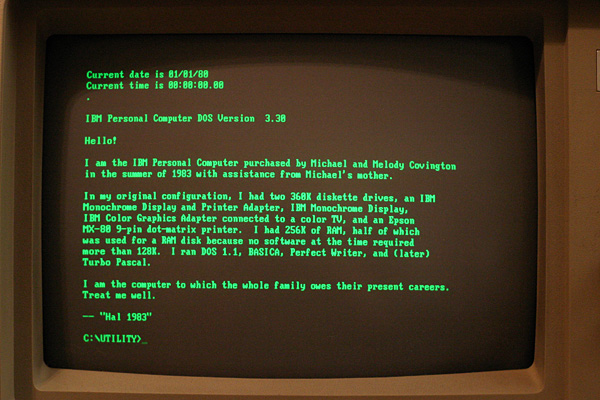
Permanent link to this entry
 
|

|
2006
July
9
|
You have a name. Use it!
(I want to assure you that the following has nothing to do with the
outstanding graduate student mentioned yesterday; it's based on a separate
situation that arose several months ago.)
One of the odder difficulties I've run into, as an educator, is that some young
women are unwilling to use their real names on professional activities.
We get a flurry of first names, nicknames, and AOL screen names on
correspondence and web pages that need to show a young scholar's full,
real name, so that the young scholar can become known to the community and
eventually get a job offer.
Why?
Have these young women been inoculated with unreasonable fear that if
someone finds out their name, bad things will happen to them?
Admittedly, I don't advocate giving out your home address or other personal
information indiscriminately. But your name and institution are not private
information. They are your professional identity and you cannot succeed
in a profession without them.
Training women to live in fear is a great way to totally obliterate women's
rights. Instead of actually putting women in danger, their
enemies need only convince them they're in constant danger. Or, worse,
their so-called friends can convince them they're in danger from enemies
that may not even exist! That's a terrible thing to do to 50% of the human
species. (And I'm convinced that most limitations on women's rights come from
what women do to each other, not from "oppression" by men. But that's
another story.)
More generally, unreasonable fear breeds actual danger. If you act
intimidated, then if people actually want to intimidate you, they'll feel
they're succeeding. (It's as if you're sending a message: "Here I am!
Intimidate me!") But if you act strong, the people trying to frighten you
will themselves be frightened. That, after all, is how we deal with terrorists
and playground bullies.
Then there's what I call modern superstition. Somehow, the notion has
gotten out that if you use your real name on the Internet, or give it out in
any other way, you'll be kidnapped.
I think this comes from two things. One is the way schools deal with child-custody
disputes. Often it's important to keep the wrong parent from making off
with a child. To avoid revealing what's actually going on, schools and other
institutions give out the notion that children's names must be kept secret from
the public because they are in danger of being "kidnapped." The children come
out convinced that any of them could be attacked by an evil force at any
time, if only it gets hold of their name.
The second is the steady stream of teenagers voluntarily running away to
meet predators who have contacted them on the Net. That is a serious problem,
but it is not kidnapping and is no reason for adults to be afraid to use their
real names on professional correspondence. Do you use your real name on the
telephone?
Getting back to the anonymous graduate students, I suppose another possibility
is that some people really want to run away from people they keep
meeting in transitory social (?) encounters. (I encountered a few cases of this
while handling computer security in the 1990s.)
My advice to them: Conduct your social life more responsibly. If your hobby is
picking up people in bars and not letting them know exactly who you are, then
you are not going to succeed in any job that requires you to be
recognizable in the community. Certainly not in science, where the community is
worldwide. You can't live your whole life anonymously.
And, finally, it may just be desire to prolong childhood. As an adult,
you have a definite name and are known by it. You have to leave the world of
make-believe (complete with fantastic AOL screen names) and be the same person
everywhere you go. Some people may reach age 25 or 30 without being ready for
this.
Permanent link to this entry
Miscellany
As you can see, I am again experimenting with Google Ads in this
Notebook and on some other pages. I have mixed feelings about this. It brings
in just enough money to pay for the web site (whose costs have gone up with a
recent large increase in popularity) but I don't know whether to trust the
advertisers. If you see anything manifestly unsuitable on any of my ad bars,
please let me know.
Here is a good interview with John McCarthy, of Stanford, about artificial
intelligence. That's the field of science that I work in, and he is one
of its founders.
Finally, did you hear about the
counterfeiter who made billion-dollar bills? I still
wonder exactly who they were intended to fool. Even if you didn't know anything
about U.S. currency, you might reasonably understand that a billion
dollars is way too much money to carry in your pocket. (It is enough to
pay your living expenses for 40,000 years.) What amuses me is that he
somehow got his neighbors, who were keeping his equipment for him, to believe
that the bills were authentic.
Permanent link to this entry
 
|

|
2006
July
7-8
|
Congratulations

Photo by Melody Covington
Congratulations are in order for Dr. Congzhou He, whose research I have
enjoyed directing and who has now finished her Ph.D. Her dissertation, on the
use of computer analysis of speech to assess mental illness, will soon be on
line on the CASPR web
site. We're already planning a flurry of research projects that will use the
software she developed. This is actually her second Ph.D.; she has a
doctorate in English linguistics from Shanghai.
Congzhou's degree will be conferred on August 5, but she may not be able to
come to graduation because she's already taken a job at
Inxight in Boston.
Fortunately, our University Bookstore was willing to lend me a set of regalia
(cap, gown, and hood) for Congzhou to wear just long enough to take a picture
— which you see above. I'm decked out as a Yale Ph.D., in a
black-and-blue academic gown (the right colors to symbolize some aspects of the
Yale experience!), and Congzhou is wearing the slightly more elegant attire of
a Georgia Ph.D. (This is, by the way, highly exceptional. They
normally rent these things, not lend them. Try getting
Hertz to lend you a car... I was lucky.)
Like all American college faculty members, I have to wear my own regalia when I
go to graduation or participate in certain other ceremonies. So I bought the
full set from Yale when I graduated. Except that, actually, I didn't go to
graduation at Yale; so I wore my Yale regalia for the first time at Georgia
when Martin Volk, my first graduate student, got his master's degree in 1986.
Academic caps, gowns, and hoods are derived from the normal attire of scholars
in the Middle Ages. Around the time of Henry VIII, specific types of
attire were prescribed to indicate a person's degree or function in the
university. Until the mid-20th century, students and faculty members at
Oxford and Cambridge had to wear gowns to classes, and they still wear them to
formal dinners and some other special events, although as a matter of humility,
doctors normally wear the black gown of a master's degree, and the scarlet gown
of a doctor is rarely seen.
American gowns are standardized by intercollegiate agreement, although a few
universities, such as Yale, have their own traditions. In America, the
doctor's gown is black and has three velvet bars on each arm, and a long hood;
the master's gown has a shorter hood and no bars; and the bachelor's gown,
plain black and always closed at the front, is worn with a short hood or no
hood at all. Degrees below a bachelor, such as associate's degrees or
high-school diplomas, are indicated by bachelor-style gowns of colors other
than black.
The cap — usually a square mortarboard, but in my case and Congzhou's, a
European hat called a tam — is optional. The tassel, in
America, indicates the type of degree: white for arts, yellow for science, blue
for education, and gold for advanced degrees.
The hood, I should add, doesn't go on your head, and hasn't since about 1600,
although that was its original function. Its only purpose today is to
hang down your back, its length indicating your degree.
And now you know.
Permanent link to this entry
 
|

|
2006
July
6
|
Space Shuttle and ISS
To better accommodate heavy demand, "How to Photograph the Space Shuttle"
has been moved to a separate page. Click here
to see it.
Permanent link to this entry
Cheap speakers
 There is some gossip, on audio newsgroups, that the
Insignia NS-B221 6 1/2-inch bookshelf speakers at Best Buy are
surprisingly good for their price ($50 a pair).
There is some gossip, on audio newsgroups, that the
Insignia NS-B221 6 1/2-inch bookshelf speakers at Best Buy are
surprisingly good for their price ($50 a pair).
Or maybe it's meta-gossip: the gossip says there is gossip to the effect that
the speakers are good.
Anyhow, I bought a pair last night — for $35 with some coupons I had
— and am able to report that they are indeed well worth that price, and
certainly better than the aging Minimus-7's that were on my workroom stereo.
I've paid more money for worse speakers 30 years ago.
I am not equipped to evaluate speakers critically and can't say whether these
are good by audiophile standards.
Permanent link to this entry
 
|

|
2006
July
5
|
How I fixed the hum in my computer speakers
 Minerva, my main computer, has three amplified speakers, one woofer and two
tweeters. The system goes by the name Juster 3D-FX1 and was chosen
mainly for
low price.
Minerva, my main computer, has three amplified speakers, one woofer and two
tweeters. The system goes by the name Juster 3D-FX1 and was chosen
mainly for
low price.
The other day they developed an annoying hum, and this evening I established
that the hum came from the subwoofer box, which contains the amplifier, and not
from the computer or the tweeters. So I opened it up to attempt a repair.
I expected a power supply problem, but an oscilloscope showed a 1-MHz
oscillation across the speaker. The bass amplifier is an
LA4597 and uses a 3.3-ohm resistor and 0.1-μF capacitor on each
output to prevent this kind of oscillation. I checked out that part of the
circuit and couldn't find anything wrong.
It became evident that the problem was sensitive to movement or flexing of the
circuit board, so I looked for a soldering problem. I found one, all right. Ten
of the LA4597's 13 pins were not soldered in! They had some solder on
and around them, but there was a tiny air gap between the pin and the
surrounding pad, just as if a desoldering pump had been used on them.
Judging from the milky-white appearance of all the solder, I think the main
circuit board wasn't soldered at a high enough temperature. Maybe these people
were already using lead-free solder (required now in Europe) and were still
using the temperatures for the older, leaded kind.
Anyway, now it sounds...er...as good as it ever did!
Permanent link to this entry
 
|

|
2006
July
4
|
Jupiter in 3-D
 
These are the same 2 Jupiter images as yesterday, but swapped so they make a
better stereo pair. To be precise, the planet will now appear planet-shaped
instead of concave!
To view them as a 3-D stereo image by the crossed-eye method, do the following:
Back up until you're at least 2 feet away from the screen.
Hold your fingertip halfway between your face and the images of Jupiter.
Focus your eyes on your fingertip.
Without moving your eyes, notice the Jupiter images. You should see three of
them. The middle one is the fused 3-D image.
Finally, without changing the direction of your gaze, focus on the 3-D Jupiter
image.
This worked so well that I decided to go back to my video recordings and make a
better stereo pair. I had started with two recordings, in rapid succession, of
133 seconds each. I went back and extracted the first minute of the first
recording (900 video frames) and the last minute of the second recording. That
means, measured middle-to-middle, they are about three and a half minutes
apart. What's more, because the planet only rotated one minute during each
picture, they should be sharper. Here's the result:

Enjoy the view! It's grainy, and by sheer happenstance the picture on the left
is sharper. The picture on the right was taken first; for viewing with the
crossed-eye method, that's how you want it.
Permanent link to this entry



 
|

|
2006
July
3
|
The further progress of Jupiter's 2 red spots
 
These images were taken around 10:30 p.m. last night (July 2) using my 8-inch
telescope. Each is from a video sequence recorded with a ToUCam Pro. The first
was taken in native 640x480 mode; the second had the pixels combined 2x2,
yielding a much smoother 320x240 image that is not quite as sharp. Notice how
much the planet rotated in just seven minutes.
The two Red Spots are very close to merging, if that's what they're going to
do. As before, the Little Red Spot is directly above the Great Red Spot and
adjacent to it. (These pictures have south up, planetary east to the left, as
is customary in astronomy.) The Jupiter observing season won't last many more
weeks — at least if you have tall trees blocking your western horizon, as
I do — so it will be interesting to see what has happened when Jupiter
comes into view again next year.
Permanent link to this entry
 
|

|
2006
July
2
|
A point of biology relevant to the abortion debate
Those who argue in favor of unrestricted abortion often report that, according
to modern science, human embryos are so likely to die naturally, unnoticed, at
an early stage of development that artificially induced abortions hardly add
anything to the total number of deaths.
What I did not know until recently is that this claim of an enormous embryonic
death rate is
hotly disputed and apparently comes only from one flawed study
conducted 50 years ago.
Permanent link to this entry
Miscellany
The Make: Blog
remains one of my favorite things on the Internet, and I think it is triggering
a genuine outpouring of creativity, perhaps even reviving electronics as a
hobby.
But I worry when I see projects copied without acknowledgment from other
magazines (not Make's fault, and the instance that we found was taken
off promptly), or a proliferation of homemade explosive projects, or, worst of
all,
this, which looks like a hot new idea for a gangster weapon.
Desoldering with a clothes iron: Apparently just the thing for dealing
with surface-mount ICs. Video
here, captioned in German but self-explanatory.
Not being a physicist, I never understood what String Theory was all about,
and apparently now it's being
seriously called into question for not having made any empirical
predictions. Hmmm...
Here's what Microsoft says about how your software should behave under
Windows Vista. Most of this is just good practice, already familiar
from Windows XP.
Our "operating-system zoo" now includes Windows 95 on an old 486 machine
on which Cathy is happily playing Monkey Island. That's Windows 95, 98,
NT 4, XP, and Vista, and DOS, OS/2, and Linux, available in two rooms of our
house. Not quite all at the same time, of course! Linux and Windows 95 each
have a seldom-used machine all to themselves.
Permanent link to this entry
 
|

|
2006
July
1
|
A stapler and the art of diagnosis
 The other day, at the office, after many tries and much pondering, I fixed a
stapler.
The other day, at the office, after many tries and much pondering, I fixed a
stapler.
Colleagues wondered why I'd spend my time doing that, when the cost of
employing me, per hour, with overhead, is appreciably more than the cost of a
new stapler.
The answer is that I like puzzles and find them instructive. This was an
instructive one.
The symptom was that the handle of the stapler absolutely would not press down.
Something was jammed. There were definitely staples in it (until we took them
out); that was the first thing we checked.
I don't know what the parts of a stapler are called, so I'll call the crucial
ones the channel, the pusher, and the knife. The channel
holds a stack of staples. The pusher, which is spring-loaded, pushes them to
the front, and the knife, actuated by the handle, shears off one staple and
drives it into the paper.
Well... The handle absolutely wouldn't go down. On the front of this stapler is
a little cover, in front of the knife, that can be removed to clear jams. We
opened it up with great difficulty and a staple fell out. Then what? The handle still
wouldn't go down.
This led to much fiddling with the mechanism, lubrication, and comparison to
another similar stapler. Eventually I had a Homer Simpson D'oh! moment: You
can't test a stapler with no staples in it. Unlike simpler staplers,
this one has a pusher that is designed to keep the knife from coming
down when there are no staples in it. That gives you a positive indication
you've run out of staples.
So... I think I cleared the actual jam at a fairly early stage, but then was
misled by my own tests until, on a hunch, I put the staples back in and tried
the stapler, and it worked.
What do I learn from this? That one kind of difficult diagnosis is the kind
where the treatment produces the same symptoms as the original problem.
A medical example is treatment of mild asthma, which manifests as a cough, with
a bronchodilator, which can also cause a mild cough. Technological examples are
numerous.
And that's what a stapler taught me about logic.
Permanent link to this entry
Newfangled HTML
Starting now, this blog (at least the page containing each month's entries) is
written in pure HTML 4.0, approved by the very picky syntax-directed editor in
Visual Studio 2005 with all the checking turned on.
The conversion was a bit frustrating. I was using the formerly excellent book HTML
and XHTML: The Definitive Guide, by Chuck Musiciano and Bill Kennedy.
Earlier editions were excellent.
This one adds styles and CSS — exactly what I needed. But it adds them in
the form of a 54-page chapter that is written like a paraphrase of a standards
document, not a "how-to" book. And throughout the rest of the book, there are
remarks that "This feature is deprecated (not recommended) in HTML 4.0 because
you can do the same thing with style sheets" but no exact indication of
how to do so.
I still recommend this book, but not for CSS and styles, which seem to have
been inserted into it without being properly combined with the existing text.
Permanent link to this entry
Must we program in fixed-pitch type?
For an extremely long time, it has been customary to print computer programs in
fixed-width type, like this:
for (int i=n; i>0; i--)
{
Console.WriteLine("{0} bottles of {1} on the wall",i,n);
Console.WriteLine("Take one down...");
}
Why? Because that's how everything looked on a computer screen or printer
listing 30 years ago. Programmers got used to it and relied on fixed pitch to
line things up into columns.
But guess what? In 2006, indentation in computer programs is common, but
columns are not. And indentation does not rely on all characters being the same
width. We can perfectly well write:
for (int i=n; i>0; i--)
{
Console.WriteLine("{0} bottles of {1} on the
wall",i,n);
Console.WriteLine("Take one down...");
}
which is much easier to read. The only thing that might be lost is the ability
to count spaces within a quoted string, but they need to be indicated
explicitly anyhow.
So I've set Visual Studio to use Verdana type on the screen, and we'll see how
I like it. The improvement in legibility is worthwhile. With fixed-pitch type,
every letter has to be as wide as M, so most of the letters end up too wide for
optimal legibility.
Permanent link to this entry
End of an era
For the first time since mid-June of 1984, 22 years ago, I am no longer an
employee of the University of
Georgia computer center.
I haven't lost my job, nor am I going anywhere. The
Artificial Intelligence Center has been moved into the
Franklin College of Arts and Sciences, where it arguably should have
been for a long time.
This is only a change in the organizational chart. We keep the same office
space, employees, and budget.
Permanent link to this entry
 
|

|
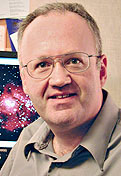






 While I wasn't looking,
While I wasn't looking,
 I've been tinkering with
I've been tinkering with 














